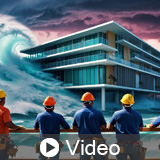
Surviving the Storm: Strategies for Resilient Design
Elixir Environmental works with building product manufacturers to develop transparency documentation for material ingredient reporting, including Health Product Declarations (HPD). HPDs help contribute points under LEED v4. Product declarations offer your customers an unsurpassed level of transparency, can validate claims of your product's contents, and increase the chances of your building product getting specified.
As severe weather events and rising sea levels threaten to reshape our coastlines and devastate communities, our team discusses cutting-edge strategies to create resilient, sustainable structures that can withstand nature's fury. We explore LEED v4.1's robust framework for climate-adaptive design, exploring innovative techniques for flood mitigation and storm-resistant construction. Our team utilizes Florida as a pivotal case study to illustrate the devastating impacts of extreme weather events and to explore innovative solutions for future resilience. Join us to learn how resilient design strategies can help fight the impacts of climate change, ensuring the safety of occupants and the longevity of coastal communities for generations to come.
- Explore how extreme weather events can damage buildings, threaten occupants, and leave a path of destruction in coastal communities.
- Review the LEED v4.1 BD+C Assessment and Planning for Resilience pilot credit and how it can prepare buildings for potential impacts of natural disasters and protect occupants.
- Examine the LEED v4.1 BD+C Designing for Enhanced Resilience pilot credit and how it can help construct buildings that can resist natural disasters and weather events.
- Discuss how LEED v4.1 BD+C integrates and compliments the ReLi rating system, and how they can help promote resilient design to combat the impacts of climate change.





